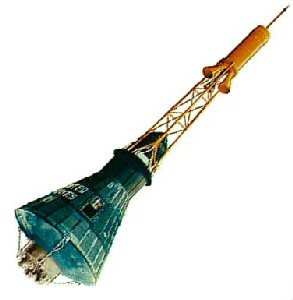The Fight Over Gus's Spacesuit
Think that today's kids
aren't involved, or learning anything in high school? Don't say
that to 15-year-old Amanda Meyer -- she might be the best hope of
resolving the ongoing battle over a true piece of history from the
earliest days of the United States space program.
The high school sophomore from Madison, CT has been waging a
letter-writing, phone and Internet campaign to convince federal
officials to give back Virgil I. "Gus" Grissom's Mercury spacesuit
to his family, ever since she first learned about the late
astronaut while researching a school project on heroism in
February.
"I'm going to keep working until the suit is handed over," said
Meyer. "No matter who ‘owns’ the suit, NASA should do
right by the Grissom family and let the suit be displayed where
they want it displayed."
Meyer is meeting on Monday with Dan LeBlanc, chief executive
officer of the company that oversees the operation of the Astronaut
Hall of Fame in Titusville, FL, where the suit is currently
displayed. Meyer will try to convince LeBlanc to allow the family
to display the suit in the Gus Grissom Memorial Museum, near the
astronaut's birthplace in Mitchell, IN.
Calling Meyer "a wonderful lesson in activism," LeBlanc is not
sure if he'll be able to help. "I’m not sure there’s
much I can do for her," he told reporters, noting that he is a NASA
contractor, not a NASA official.
He added that the Hall of Fame is "so very proud" to have
Grissom's suit on display. It is the only flight suit in their
collection.
The spacesuit in question was worn by Grissom on his suborbital
Liberty Bell 7 flight in 1961. It was America's second flight into
space, preceding John Glenn's first orbital flight later that year.
The suit has been at the Astronaut Hall of Fame since it was
donated by Grissom's family to the then-privately funded museum in
1990. Before that it hung in a clothes closet, after being rescued
from the scrap heap in 1961, according to the family.
The tug-of-war between NASA and Grissom's family began in 2002,
when the Astronaut Hall of Fame was taken over by a NASA
contractor. The family then asked for the items they had donated to
be returned. They got back Grissom's watch, cowboy hat, a patch and
a US flag -- but NASA refused to return the spacesuit.
"They are just a bunch of thieves," said Betty Grissom, 78, the
astronaut's widow.
According to NASA, the astronaut signed out the suit --
considered to be property of the space agency -- in 1965 to take to
a show-and-tell for his children. NASA maintains that Grissom never
brought it back, and that they have simply reclaimed lost
property.
Gus Grissom died in the Apollo 1 launchpad fire on Jan. 27,
1967, after also having flown in the United State's first two-man
space capsule, Gemini 3, in 1965.

Grissom's Mercury flight ending infamously when the Liberty Bell
7 capsule began taking on water after splashdown. Grissom fought
public allegations for years that he had panicked and blown out the
hatch prematurely, although a NASA probe cleared Grissom of any
error.
In a tongue-and-cheek reference to the Mercury debacle, Grissom
later christened his Gemini capsule "Molly Brown," after the
"unsinkable" title character in a Broadway show.
 Aero-News: Quote of the Day (04.28.25)
Aero-News: Quote of the Day (04.28.25) ANN's Daily Aero-Term (04.28.25): Decision Altitude (DA)
ANN's Daily Aero-Term (04.28.25): Decision Altitude (DA) ANN's Daily Aero-Linx (04.28.25)
ANN's Daily Aero-Linx (04.28.25) Airborne-Flight Training 04.24.25: GA Refocused, Seminole/Epic, WestJet v TFWP
Airborne-Flight Training 04.24.25: GA Refocused, Seminole/Epic, WestJet v TFWP Aero-News: Quote of the Day (04.29.25)
Aero-News: Quote of the Day (04.29.25)



